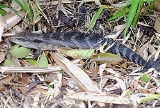
Eastern blue-tongued lizard
Encyclopedia
The Eastern Blue-tongued Lizard (Tiliqua scincoides scincoides) is a subspecies
of large skink
which is common throughout Eastern Australia
, often found in bushland
and suburban areas where conditions are suitable. They are known as blue-tongues because their tongue ranges from bright to dark blue, and they have a habit of displaying it prominently and hissing loudly when disturbed.
The Eastern Blue-tongued Lizard is a stout and slow lizard that grows up to 30-60 cm in length, with brown to grey scales and a barred pattern across the body and tail. The underside is usually pale. Blue-tongued Lizards are popular as pet
s and can live for up to 30 years in captivity. They give birth to live young, between six to a record twenty per litter. The young consume the egg sac immediately after birth. They resemble the adult form closely. There are several other types of blue-tongued lizard, genus Tiliqua, such as the Northern Blue-tongued Skink
and the shingleback or stump-tailed skink
.
This subspecies was first described as Lacerta scincoides, by John White
, in Journal of a Voyage to New South Wales, 1790.
Subspecies
Subspecies in biological classification, is either a taxonomic rank subordinate to species, ora taxonomic unit in that rank . A subspecies cannot be recognized in isolation: a species will either be recognized as having no subspecies at all or two or more, never just one...
of large skink
Skink
Skinks are lizards belonging to the family Scincidae. Together with several other lizard families, including Lacertidae , they comprise the superfamily or infraorder Scincomorpha...
which is common throughout Eastern Australia
Australia
Australia , officially the Commonwealth of Australia, is a country in the Southern Hemisphere comprising the mainland of the Australian continent, the island of Tasmania, and numerous smaller islands in the Indian and Pacific Oceans. It is the world's sixth-largest country by total area...
, often found in bushland
Bushland
Bushland is any area in Australia that is predominantly indigenous flora and fauna.Bushland is the term commonly used by conservation protection groups and other environmental groups as a blanket term for natural vegetation, which may cover any kind of habitat from open shrubby country with few...
and suburban areas where conditions are suitable. They are known as blue-tongues because their tongue ranges from bright to dark blue, and they have a habit of displaying it prominently and hissing loudly when disturbed.
The Eastern Blue-tongued Lizard is a stout and slow lizard that grows up to 30-60 cm in length, with brown to grey scales and a barred pattern across the body and tail. The underside is usually pale. Blue-tongued Lizards are popular as pet
Pet
A pet is a household animal kept for companionship and a person's enjoyment, as opposed to wild animals or to livestock, laboratory animals, working animals or sport animals, which are kept for economic or productive reasons. The most popular pets are noted for their loyal or playful...
s and can live for up to 30 years in captivity. They give birth to live young, between six to a record twenty per litter. The young consume the egg sac immediately after birth. They resemble the adult form closely. There are several other types of blue-tongued lizard, genus Tiliqua, such as the Northern Blue-tongued Skink
Northern Blue-tongued Skink
Northern Blue-tongued Skinks are the largest and heaviest of the Blue-tongued Lizards . They are native to Australia and found almost exclusively in the Northern Region...
and the shingleback or stump-tailed skink
Stump-tailed skink
Tiliqua rugosa is a short-tailed, slow moving species of blue-tongued skink found in Australia. Three of the four recognized subspecies are found only in Western Australia, where they are known collectively by the common name bobtail. The name shingleback is also used, especially for T. rugosa...
.
This subspecies was first described as Lacerta scincoides, by John White
John White (surgeon)
John White was an English surgeon and botanical collector.White was born in Sussex and entered the Royal Navy on 26 June 1778 as third surgeon's mate. He was promoted surgeon in 1780, and was the principal surgeon during the voyage of the First Fleet to Australia...
, in Journal of a Voyage to New South Wales, 1790.
External links
- BlueTongueSkinks.net
- Blue-tongued Skink, Honolulu Zoo
- Blue-tongued Skinks, Melissa Kaplan's Herp Care Collection
- Tiliqua scincoides , James Cook University

